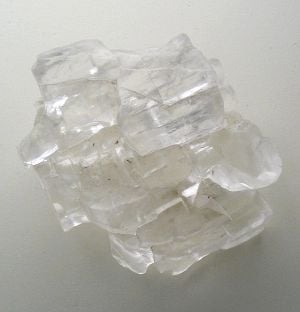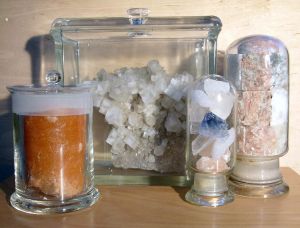Halite
 From Nwe
From Nwe | Halite | |
|---|---|
 |
|
| General | |
| Category | Halide mineral |
| Chemical formula | Sodium chloride NaCl |
| Identification | |
| Color | clear or white; also blue, purple, pink, yellow, and gray |
| Crystal habit | predominantly cubes and in massive sedimentary beds, but also granular, fibrous and compact |
| Crystal system | isometric 4/m bar 3 2/m |
| Cleavage | perfect in three directions |
| Mohs Scale hardness | 2 - 2.5 |
| Luster | vitreous |
| Refractive index | 1.544 |
| Streak | white |
| Specific gravity | 2.1 |
| Solubility | in water |
| Other Characteristics | salty flavor |
Halite is the mineral form of sodium chloride, NaCl, commonly known as rock salt. Halite occurs as cubic crystals that are typically colorless to white, but may also be light blue, dark blue, or pink. It commonly occurs with other evaporite deposit minerals such as several of the sulfates, halides, and borates.
Occurrence


Halite occurs in vast beds of sedimentary evaporite minerals that result from the drying up of enclosed lakes, playas, and seas. Salt beds may be up to 350 meters (1150 feet) thick and underlie broad areas. In the United States and Canada extensive underground beds extend from the Appalachian basin of western New York through parts of Ontario and under much of the Michigan basin. Other deposits in the region are in Ohio, Kansas, New Mexico, Nova Scotia, and Saskatchewan.
Salt domes and glaciers
Salt domes are vertical diapirs or pipe-like masses of salt that have been essentially "squeezed up" from underlying salt beds by mobilization due to the weight of overlying rock. Salt domes typically comprise anhydrite (anhydrous calcium sulfate, CaSO4), gypsum (CaSO4·2H2O), and native sulfur, in addition to halite and sylvite (potassium chloride (KCl)). They are common along the Gulf coasts of Texas and Louisiana and are often associated with petroleum deposits. Germany, Spain, the Netherlands, Romania, and Iran also have salt domes. Salt glaciers exist in arid Iran, where the salt has broken through the surface at high elevation and flows downhill. In all these cases, halite is said to be behaving in the manner of a rheid.

Unusual formations
Unusual, purple, fibrous veins running through halite crystals are found in France and a few other localities. Halite crystals termed hopper crystals appear to be "skeletons" of the typical cubes, with the edges present and stairstep depressions on, or rather in, each crystal face. In a rapidly crystallizing environment the edges of the cubes simply grow faster than the centers. Halite crystals form very quickly in some rapidly evaporating lakes resulting in modern artefacts with a coating or encrustation of halite crystals. Halite flowers are rare stalactites of curling fibers of halite that are found in certain arid caves of Australia's Nullarbor Plain. Halite stalactites and encrustations are also reported in the Quincy native copper mine of Hancock, Michigan.
See also
- Sodium chloride
- History of salt
References
ISBN links support NWE through referral fees
- Farndon, John. The Practical Encyclopedia of Rocks & Minerals: How to Find, Identify, Collect and Maintain the World's best Specimens, with over 1000 Photographs and Artworks. London: Lorenz Books, 2006. ISBN 0754815412
- Klein, Cornelis, and Barbara Dutrow. Manual of Mineral Science. 23rd ed. New York: John Wiley, 2007. ISBN 978-0471721574
- Kurlansky, Mark. Salt: A World History. New York: Penguin, 2003. ISBN 0142001619
- Pellant, Chris. Rocks and Minerals. Smithsonian Handbooks. New York: Dorling Kindersley, 2002. ISBN 0789491060
- Shaffer, Paul R., Herbert S. Zim, and Raymond Perlman. Rocks, Gems and Minerals. Rev. ed. New York: St. Martin's Press, 2001. ISBN 1582381321
- Mineral Gallery. The Mineral Halite. Amethyst Galleries, 2006.
- Spiroff, Kiril. An Unusual Occurrence of Halite. American Mineralogist. 22:931-33, 1937. Retrieved September 10, 2007.
External links
All links retrieved July 25, 2017.
- Halite Mineral Data WebMineral.com.
- The Mineral and Gemstone Kingdom: Halite Minerals.net.
- Halite DesertUSA.
Credits
New World Encyclopedia writers and editors rewrote and completed the Wikipedia article in accordance with New World Encyclopedia standards. This article abides by terms of the Creative Commons CC-by-sa 3.0 License (CC-by-sa), which may be used and disseminated with proper attribution. Credit is due under the terms of this license that can reference both the New World Encyclopedia contributors and the selfless volunteer contributors of the Wikimedia Foundation. To cite this article click here for a list of acceptable citing formats.The history of earlier contributions by wikipedians is accessible to researchers here:
- Halite history
The history of this article since it was imported to New World Encyclopedia:
- History of "Halite"
Note: Some restrictions may apply to use of individual images which are separately licensed.
↧ Download as ZWI file | Last modified: 02/04/2023 02:46:05 | 61 views
☰ Source: https://www.newworldencyclopedia.org/entry/Rock_salt | License: CC BY-SA 3.0
 ZWI signed:
ZWI signed: KSF
KSF